Last Updated on April 28, 2022 by asoulwindow
Table of Contents
Difference between Manasarovar Lake and Rakshastal
Despite being located in close proximity with each other, Mansarovar Lake and Rakshas Tal are poles apart in terms of characteristics.
On one hand the pious Mansarovar Lake has an inviting appearance and devotees queue up to take bath in its holy water and drink it, on the other hand no one even dares to walk towards the adjacent Rakshas Tal lake, thanks to its turbulent appearance and the negative stories associated with this cursed lake.
What baffles most of the scientists, devotees and Governments alike is the sheer difference between the two lakes despite being located so close to each other.
I stopped at Lake Rakshastal for few minutes while travelling from Mansarovar lake to Yam Dwar via Darchen for the parikrama or kora. Distance between Rakshas Taal and Lake Mansarovar is only 3.7 kilometres or around 2.3 miles. Rakshastal lies west of Manasarovar Lake and south of Mount Kailash (as the west calls it).
Based on my own travel experience, this is the most comprehensive guide on the main difference between Mansarovar lake and Rakshastal.
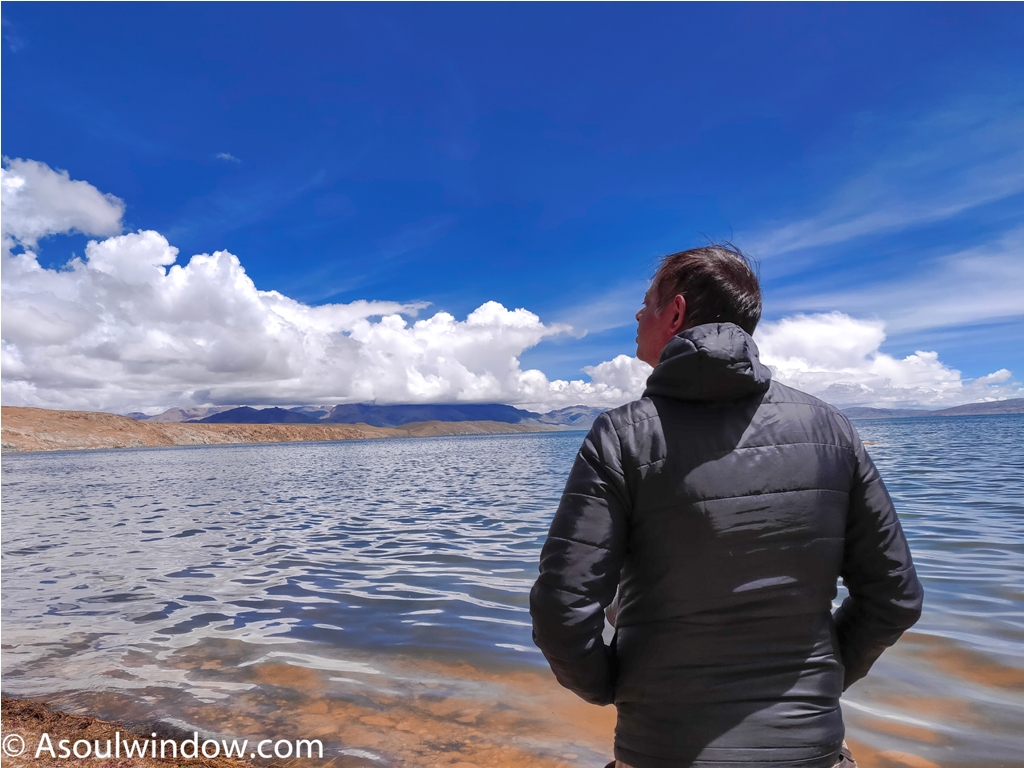
Mansarovar Versus Rakshas Taal
Rakshas Taal versus Mansarovar lake question is a commonly asked question. Two of the most iconic Tibetan Lakes, Rakshas Taal and Manasarovar, have several mysterious legends linked with their origins. Despite such proximity, there is no common historic religious significance shared by Rakshas Tal and Mansarovar Lake. This stark contrast between the two adjacent lake is inexplicable by science.
Buddhist Philosophy
Devout Buddhists symbolically interpret Mansarovar Lake with lightness and Rakshas Tal with darkness respectively. Buddhist philosophy is very much based on Hindu philosophy. This is so because Buddhism is derived from Hinduism from India. Therefore, much of what Buddhism teaches is Hindu philosophy only.
Hindu Philosophy
Here is all you wanted to know about how Hinduism compares Manasarovar Lake with Rakshastal. As per Hinduism, Mansarovar Lake is the lake of God viz Brahma ji, Shiv Bhagwan and Parvati Maa while Rakshas tal is the lake of devil or Ravan. This is also why one lake is celebrated and the other lake is looked down upon.
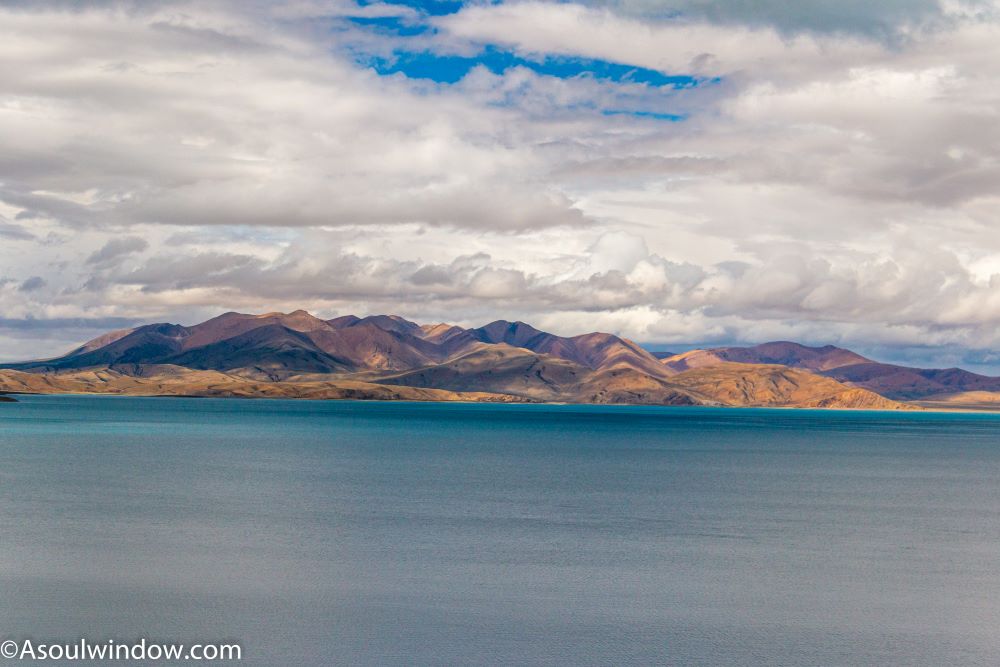
Fresh water versus Salt water
Not many devotees know that both Mansarovar Lake and Rakshas Taal are connected to each other via Ganga Chuu channel.
Yet the water of Mansarovar Lake is fresh water while that of Rakshas Taal is saline. People visit Rakshas Taal for its stunning beauty. Visually Rakshas Taal is as gorgeous as Mansarovar Lake.
Kailash Parbat, which is located close to both lakes, stands tall, facing both lakes of immense religious significance. While the Rakshas taal is crescent shaped, the Mansarovar lake is sun shaped.
No one has been able to solve the mystery as to why Mansarovar Lake is a huge freshwater lake despite being located in a relatively high elevation, especially when there are mostly saline lakes in the high-altitude Tibetan Plateau. This is a rare phenomenon which has baffled the scientists since time immemorial.
Difference in Flora and Fauna
I did not see a single human, bird or mammal near the Rakshas Taal. It seemed abandoned and unloved. While on the other hand Mansarovar Lake was buzzing with activities and positive vibes. I saw many birds, fish and aquatic life thriving at Mansarovar Lake.
I noticed only a black raven sitting in a corner of the ground near Rakshas Taal. In that barren landscape, the pitch-dark Raven appeared like a messenger of bad things. However, some say that during the winter months, the local people of Tibet use the 4 islands of Rakshas Tal as pastures for the yaks.
Also, while I noticed no vegetation around Rakshas Tal, there was plethora of green grass near Mansrovar Lake. Isn’t it strange that despite not much distance between the two lakes, the land around Mansarovar jhil is surrounded by grass while the land surrounding Rakshastal is barren?
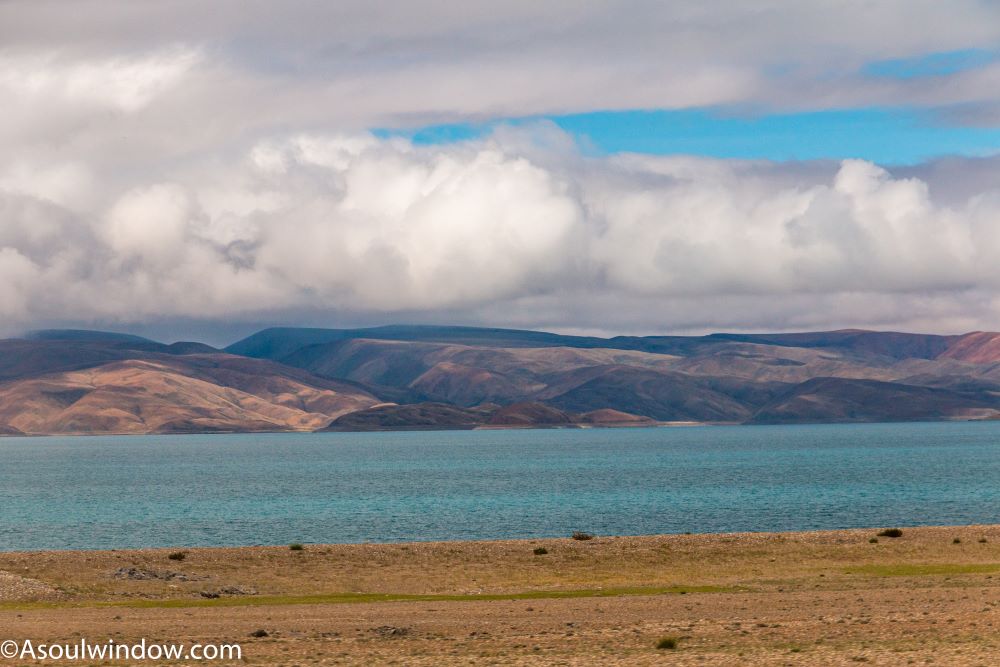
Difference in Island
What is inside Mansarovar lake? Are there any islands in Mansarovar Lake? These are some commonly asked questions about Mansarovar Lake. I didn’t notice a single island inside the vast Mansarovar Lake. However, I noticed several islands inside Rakshastal. The names of islands at Rakshas Taal are Dola, Dosharba, Lachato aka Nadzhado and Topserma.
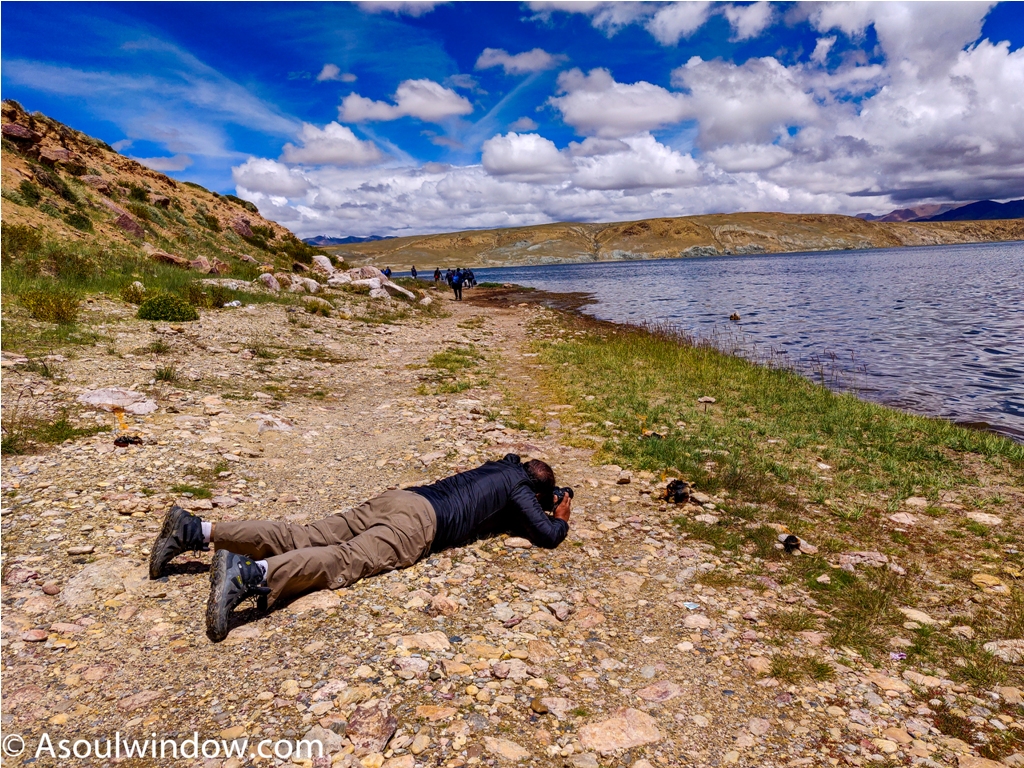
Difference in name
Some Hindus also call Rakshas Taal as Ravan Taal. Lake Rakshastal is also known as Langqen Zangbo in local Tibetan language.As per the great Hindu epic Ramayan, the demon king of Lanka, Ravan did his severe penance here in order to please Shiv Bhagwan. Rakshas literally means devil and Taal means lake. Thus, Rakshas Taal means Devil’s Lake. Rakshas Taal which is located very close to the Mansarovar Lake is considered inauspicious by Hindus.
Mansarovar lake is known as Manpang Yumso or mTsho Mapham or mTsho Ma-dros-pa. In Chinese they call it as Mapang Yongcuo. The Hindi name of Manas Sarovar or Manasarovar Jheel is made up of two root words Manas and Taal. Since Mansarovar Lake was originally imagined in the mind of Hindu deity Brahma Bhagwan, therefore Hindus consider this lake very auspicious.
Bathing rituals
Rakshas Taal is associated with demon king Ravana, volatility, negativity, impurity, moon and darkness. It is therefore one of the reasons why Hindus do not take a dip in the Rakshas Tal.
On the other hand, Manasarovar Lake is associated with Brahma ji, purity, calmness, positivity, sun and brightness. This is the reason why it is considered very auspicious to take a holy dip in the sacred waters of Manasarovar Lake.
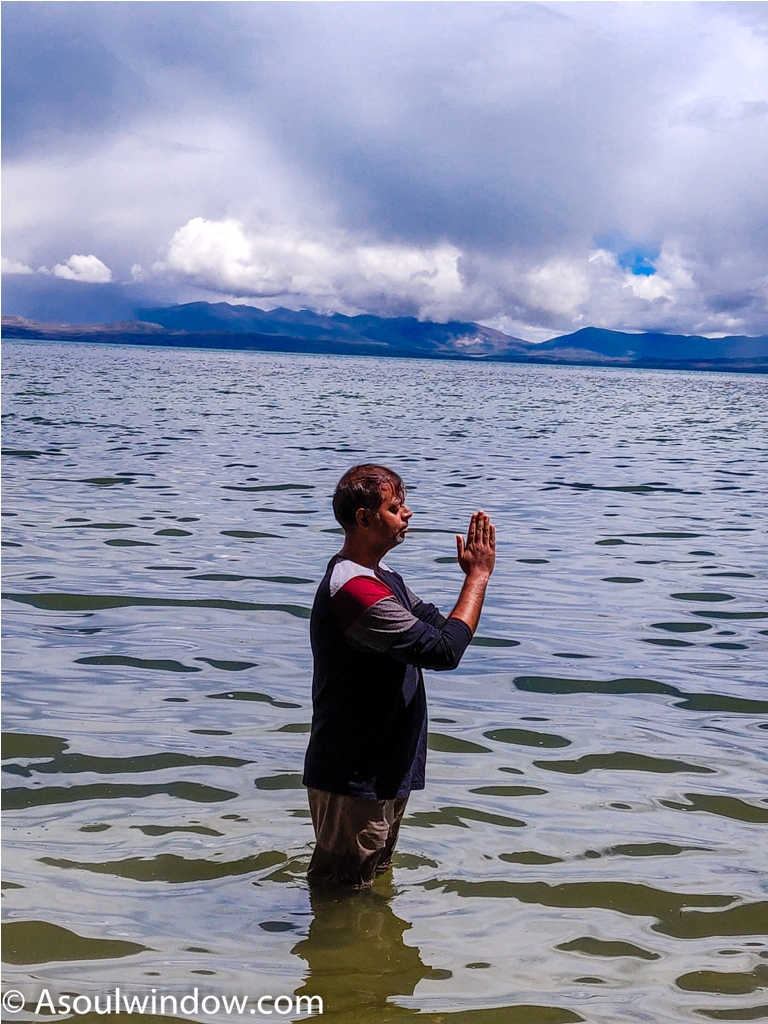
Is Rakshas Taal more beautiful than Mansarovar lake?
Visually, some people find Rakshas Tal more beautiful than Mansarovar Lake. I refuse to agree because I have seen Mansarovar Lake from all angles, including the drone like vantage point from the ancient Chiu Gompa.
The pious lake looks ethereal from the top. You can see that in the picture I shared here. Having said that, I feel both Mansarovar lake and Rakshas Taal Lake are equally stunning if not less or more!
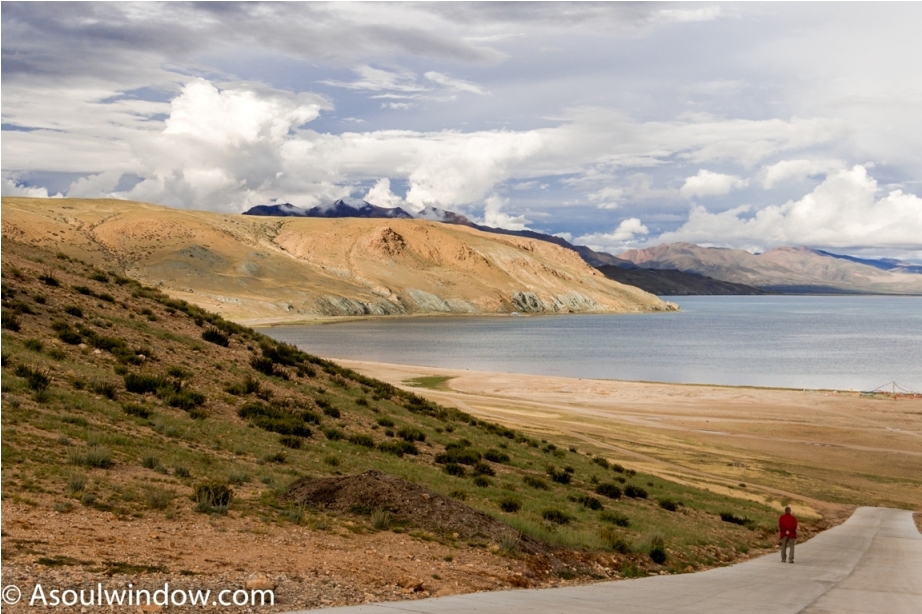
Sweet Vs Salty
The water of Mansarovar Lake is sweet while the water of Rakshas Taal is salty. I noticed that while many birds and marine organisms called Mansarovar Lake home because it is a fresh water lake, there was no sign of life at the nearby Rakshas Taal. It is one of the few places in the world where sweet and fresh water lake is found next to a salty lake, especially on a high altitude.
Perhaps, the existence of the ghost lake Laangcuo or Rakshas Taal and the sacred lake Manpangyongcuo or Mansarovar Lake is to remind humans that justice/heaven and evil/hell co-exist with each other.
It can also mean that the existence of the ghost lake Rakshas Tal and the holy Lake Mansarovar teaches humans to listen to the nature. It is a subtle message of nature that heaven and hell exist only few steps away from each other on Earth.
Good versus bad comparison
If Rakshas Taal Lake is a terrible devil, then on the other hand, Mansarovar Lake, which is separated by a mountain, is an angel. Such contrast is clearly visible in Tibet near the snow-capped Kailash Parvat.
Since times immemorial, people have been amazed at the contrast between Mansarovar lake and Rakshas Taal lake. Located in the foothills of the sacred Kailash Parvat, the juxtaposition of the two contrasting lakes in the same area also represents the fact that both heaven and hell are located just a few steps away from each other.
This is nothing less than a wonder! Call it a miracle of nature, divine phenomenon or regular geological event but we can-not look away from the fact that how the proximity between two drastically different lakes represents the good and evil that resides in all living beings.
Shape of Rakshastal versus Mansarovar Lake
The two enigmatic water bodies of Kailasha Parvat have been constantly compared with each other thanks to their contrasting shapes and stories associated with them.
While the Lake Manasarovar is round shaped ‘like the sun’, on the other hand, Rakshastal is a crescent shaped lake. The round shape of Mansarovar is associated with the positive rays of Sun or goodness, the crescent shape of Rakshastal is associated with darkness of night or evil.
Pooja at Manasarovar Jhil versus Rakshastal
Poojas, rituals are not done near Rakshas Taal. Neither does anyone meditate on the banks of Rakshas Taal.
Hindus strictly do not offer any prayer or take a dip in Rakshas Taal. I have never heard of a single Hindu who performed a pooja or prayer at Rakshas Taal.
The ‘lake of the demon’ is bereft of all the celebrations and prayers that take place in Mansarovar Lake. Neither tourists nor locals and other pilgrims were to be seen, even in far distance when I visited. I had the Rakshas Taal to myself.
On the other hand, I saw several people sitting on the shore of Lake Manasarovar and performing pooja. The group was even accompanied by a Hindu Brahmin all the way from India. He chanted ancient Hindu mantras and the devotees sang bhajan such as ‘Om Jai Jagdish Hare’. While Rakshatal is devoid of any auspicious rituals and avoided like plague, the quaint Mansarovar Lake is a magnet for ritualistic prayers and associated activities.
Calm Versus Disturbed water
The water of Mansarovar is always calm even during turbulent weather conditions. However, on the other hand, the water of Rakshastal is known to be turbulent. Even the general atmosphere around Mansarovar lake is quiet and peaceful whereas eerie stormy weather has been noticed around Rakshastal.
The restless water of Rakshastal perhaps represent the greedy and turbulent mind of the demon king Ravana. It is easy to see that the calm water of Manasarovar Jhil represents the peaceful Brahma Bhagwan.
Ganga Chhu channel
Also, very few devotees know that a short river known as Ganga Chhu channel connects Manasarovar with Rakshas Taal. Through Ganga Chhu channel, the water of Mansarovar flows in Rakshastal. This channel was created by Rishis (Hindu Holy men) in order to add pure water from Lake Manasarovar.
While the fresh water of Manasarovar Jhil also flows into Rakshastal Lake, the latter is a salt-water endorheic lake. This means that Rakshastal has no outflow to another water body like a lake or river. The only way Rakshastal loses water is through seepage into the ground or the slow process of evaporation. This is one of the lesser-known difference between Manasarovar Lake and Rakshastal.
The local people of Tibet have a special view on the Ganga Chhu channel. As per the local beliefs, the circulation of the water between the two lakes is considered auspicious. However, the day when the water of the lake dries up and the water flow between the lakes is interrupted, it will lead to unprecedented disasters to the world.
Were Rakshastal and Manasarovar Lake part of Sutlej basin?
This is a frequently asked question.Once upon a time, Manasarovar Lake and Rakshastal used to be part of the Sutlej basin. However, with time both the lakes were separated from each other due to tectonic activity. If you know more on this, then do share with me in the comment section. I keep improving my blogs with new perspectives. My blog A Soul Window has been listed as the Top Indian Travel Blog several times.

Conclusion: Why are Mansarovar lake and Rakshastal so different?
Here is my last word on the major difference between Manasarovar Lake and Rakshastal. To summarize, no scientist or seer has been able to explain why despite sharing the same geographical location, the Mansarovar and Rakshas Tal lakes are as different from each other as day and night. I personally feel that there are certain things in universe which needs no explanation and which should not be interfered with much!
In a nutshell, I believe that the co-existence of the two adjoining lakes want to tell us the obvious. The fact that the celebrated freshwater Mansarovar jheel exists right next to the salt water Rakshastal clearly shows that the good and evil, both exist in us. It also shows that the below exists together:
- Day and Night
- Sun and Moon
- Ying and Yang
- Negative and positive
- Darkness and brightness
- Calmness and turbulence
The fact that the holy Kailash Parbat or as the west calls it, Mount Kailash or Mt. Kailash oversees both Mansarovar lake and Rakshastal make it all the more meaningful. Nowhere else in the world do we get to see such a natural phenomenon. This is what makes the visit to Mansarovar Jhil, Rakshastal and Kailash Parbat so special. It is then no wonder that thousands of Hindu, Bon, Sikh, Buddhist and Jain pilgrims embark upon the once in a lifetime Kailash Mansarovar Yatra.
The views from my Soul Window are different from each other!
Pin this blog to save the blog and plan a trip later!
Top Travel Blogger from India
